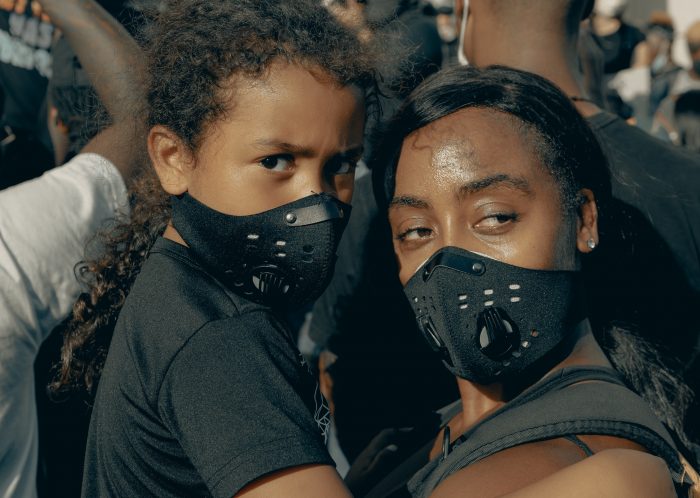I feel so sad, disappointed, and disheartened that in 2020, this topic of racism being wrong still has to be discussed.
When will racism be a topic of the past, something that used to happen and not something that is still happening!
The inhumane and brutal killing of George Floyd by those in positions of power has brought to our attention the systematic racism that occurs to this very day. This needs to end, and the beginning of this end has to start in our homes, with our children. The children, who are our hope for a better future and society.
To inspire change, we have to educate, empower, and encourage our children. We have to educate them on what racism is, how it can take place, and why it is not acceptable. We have to empower them with the knowledge, confidence, and courage required to challenge racism. We have to encourage them to speak up against racism should they themselves experience it or see it happening to others.
Here are a few tips on how to talk to your children about racism:
1. Talk about it
I know this is stating the obvious, but it has to be said. It is natural to avoid a topic that makes us feel uncomfortable or unsafe. As a parent, we might not know how to bring up the topic or we might be worried about upsetting our children. This worry or concern could then prevent you from bringing it up with your child.
Avoiding or not talking about racism and what is currently going on can give children the impression that it is a taboo topic and not okay for them to bring it up with you.
By talking about it you are initiating the conversation and indirectly permitting your children to discuss or bring up the topic of racism.
2. Explain Racism
Talk about what racism is by highlighting that all humans have similarities, and they all have differences. Talk about the similarities that we as humans have and talk about all the differences too—hair colour, eye colour, height, weight, and skin colour.
Explain to them that it is okay to be different and being different is what makes us all beautiful. There is no right or wrong way to look. Everyone is beautiful in their own way.
Emphasise it is not okay is to treat someone differently or unfairly because their skin colour is different. Echo that is never okay, never acceptable, and never will be.
3. Navigate their curiosity
Children are curious, so help them explore their curiosity by sharing with them how you feel about racism and then ask them open-ended questions to make them think about and share how they might be feeling. Questions to ask are:
>> How are you feeling?
>> What feelings do you have about racism?
>> What questions do they have?
4. Acknowledge
For children who are old enough to watch, view, and witness what is going on right now in the news or social media platforms related to the case of George Floyd, you will need to have a different conversation.
All these protests, violence, and the sheer brutality by the police might have left children questioning how safe their world actually is—how safe they themselves actually are—and also challenged their perception of those in authority who they might once have seen as trusted members of the public.
The questions here will be different and more specific to current events:
>> How are you feeling about the protests, media coverage, and videos that are currently online?
>> How are you feeling about the police?
>> What are you thinking?
>> What are your concerns, worries, or fears?
5. Reassurance
When people in positions of power betray our trust, it can leave us feeling insecure and unsafe about the world we live in. For children, it can also leave them feeling confused and challenge their reality. Most parents will raise their children with the safety message of go to the police if they are in danger; go to the police if they are in trouble; or to find a police officer if they are ever approached by a stranger.
So now all of a sudden, those very people who they thought were there to protect them have become the perpetrators themselves. We can see how this can be confusing, challenging, and contradicting to children.
This is where reassurance is important. Reassurance that not every police officer is bad; reassurance that not every police officer is the same; or helping children see all the ways in which the police are helping, involved, and fighting for justice will balance out any distorted thinking that might be causing anxiety.
6. Space
Once you have brought up the topic of racism, give your children space to process. If your children don’t ask anything or don’t have answers to your questions, then don’t push or probe. Give them time and space to process the conversation you have had but make them aware of the fact that you are there should they want to talk about anything.
Children process information differently and sometimes they need time and space to absorb, reflect, and understand what you have discussed.
7. More than one conversation
Don’t make the conversation a one-time event and then never bring it up again. The message this gives is that it is not okay to talk about racism, and it takes away the opportunity for children to ask any further questions. Be ready and prepared to bring this topic up again if you have to and should your children have any questions.
The more you talk about it, the more comfortable your children will feel bringing up the topic with you or with others should they ever have to speak up for themselves or others.
~
Watch an anti-racism hour with Jane Elliott talking with Waylon Lewis of Elephant, here.









Read 0 comments and reply